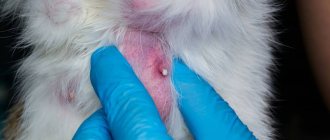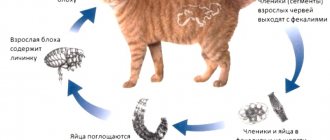What will you learn from the article?
- Causes of papillomas in cats
- Symptoms of warts in cats
- Diagnosis of papillomas in cats
- Treatment of papillomas in cats Treatment of papillomas with novocaine
- Folk remedies for treating warts in cats
Papillomas, or warts in cats, are benign skin formations similar to cauliflower inflorescences that are found not only in humans. These new growths can be different in shape, and the size ranges from the size of a millet grain to a pea or more. The color of warts can also vary, from flesh-colored to gray or yellowish. The tumor may have a small stalk or, conversely, fit tightly to the animal’s body.
Papillomas in cats are found in the ears, paws, head, neck, as well as on the mucous membranes of the mouth, eyelids and lips.
Description
When infected with a virus, warts appear on the skin. The disease is classified according to location and quantity as follows:
- Oral papilloma. It can be found in old animals, more than 7-8 years old. Also occurs in young kittens up to 5-8 months. Papillomas are located on the gums, the inside of the cheeks, and the tongue. New growths are oval, flattened.
- Single skin papillomas. Warts are found on the face, around the mouth, eyes, and ears. Less commonly, they can be found on the paws and body. Old animals, as well as young kittens, suffer from this form of the disease.
- Multiple skin papillomas. A rather rare form of papillomatosis. Manifests itself with a strong decline in resistance. The neoplasms are different in size, their crowding resembles cauliflower.
What species are found?
In cats, papillomas differ not only in location, but also in origin and other indicators. The table shows the main types of warts in cats and their brief description:
| Varieties | Location | Peculiarities |
| Oral | Oral cavity, tongue or inner cheek | This type of papilloma most often forms on the skin of a kitten that is less than 8 months old. |
| Oval shaped with flattened top | ||
| Multiple | Any part of the body | Diagnosed mainly in older cats and female cats |
| Many warts immediately appear, the size of which ranges from 3 mm to 3 cm | ||
| Papillomas are convex and pigmented | ||
| Single | Rarely found in felines | |
| It is a small swelling under the epidermis | ||
| Veterinarians have still not been able to figure out the reasons for the appearance of such papillomas in animals. |
Causes
The causative agent of papilloma in cats belongs to the Papillomaviridae family. They are DNA-containing. Eight strains of viruses that cause papillomatosis have been found in cats. The virus is resistant to environmental influences and can survive for a long time on bowls, toys and household items.
The source of infection is other representatives of the cat family. Method of transmission - direct contact or indirect (through combs, bowls, collars, toys). Infection is facilitated by crowded keeping of animals, for example, in nurseries, at exhibitions. Reduced immunity increases the likelihood of developing the disease.
Does papilloma always appear under the influence of a virus?
There is a version that the formation of warts is not always associated with the spread of viruses. This assumption sometimes turns out to be correct. Similar tumors can appear in old cats or in animals that have suffered a serious illness - in both cases, the matter is a weakening of the body’s defenses and a decline in immunity. It’s worse when these tumors are initially malignant. Sometimes the root of the problem is of a hereditary nature and lies in the presence of autoimmune diseases, which, according to experienced breeders, is confirmed in practice: papillomas present in parents quite often appear in their offspring.
Still have questions? You can ask them to our site's in-house veterinarian in the comment box below, who will respond to them as soon as possible.
Pathogenesis of papillomatosis
The mammalian epithelium is designed in such a way that the skin cells at the surface are highly differentiated, but at the same time multiply slowly. In the depths of the skin layer, on the contrary, cells quickly divide, but are poorly specialized. As the cell moves upward, it loses the ability to divide, but it differentiates.
The peculiarity of the papillomavirus is that it can only infect the lower basal undifferentiated cells. Then, together with the affected cell, it enters the periphery, where it begins to produce offspring. The degenerated cells become rounded and begin to produce daughter virions.
In a cell, the virus exists in 2 variants:
- Episomal. That is, in the nucleus of the cell, but outside the chromosomes
- Introsomal. When the virion integrates into the cell genome.
Cells infected with papillomavirus form epithelial neoplasms that are superior in size and layering. At the same time, cells transformed by viral proteins, despite differentiation, continue to divide. In addition, they accelerate metabolism, especially glycolysis, and there is no reaction to serum growth suppression factors.
The prognosis of the pathology is favorable. Often there is no need to resort to treatment, as the disease goes away on its own.
Are warts transmitted from cats to humans?
Warts are usually contagious, but only between animal species or people. That is, warts are specific bumps or growths of each species, so they can be contagious between the same species, but not between different ones.
Human warts are also contagious, but for that matter, you don't have to worry about your cat's warts—there's no risk of your cat getting warts. In any case, if you have more cats, be careful because the warts can spread to each other.
Symptoms
The duration of the incubation period is from 3-4 weeks to 2-3 months. At first, the disease manifests itself in the form of single papillomas, which later gather in groups and form a surface similar to cauliflower. Papillomas in cats at an early stage are slightly different from warts.
More often, pathology is found on the skin of the lips, nasal planum, the mucous membrane of the gums, the inside of the cheek, and the tongue. All this contributes to excessive salivation. Often, when a papilloma is injured, bleeding occurs, which increases the growth of the tumor.
Isolated cases of the formation of papillomas on the eyelids and eyeball have been described. Depending on the size of the tumors, this caused conjunctivitis, tearing, entropion of the eyelids, or even loss of vision. In addition, pathology is often found on the back, head (for example, on the ears), and limbs (usually on the pads of the paws). This growth is a consequence of already affected mucous membranes of the oral cavity.
There is an opinion that the virus affects the entire surface of the skin with the same frequency, it’s just that the owners notice them specifically on the pet’s face.
Papillomas caused by the pathogen can disappear on their own after 3-12 weeks. However, in severe cases this does not happen. Moreover, with the development of multiple papillomatosis, surgical and drug treatment is low in effectiveness.
The mechanism of the immune response in animals to papillomavirus has been little studied, but the high role of the body’s resistance is beyond doubt. Firstly, the disease is more severe if the immune system is weakened due to taking immunosuppressants or illness. Secondly, cats aged 2 to 9 years do not suffer from papillomatosis, while the pathology develops, as a rule, in old pets. After suffering from the disease, cats develop stable, long-lasting immunity. However, the animal remains a carrier of pathogens, and when resistance decreases, a relapse occurs.
Probable locations of papillomas on the body
Characteristic symptoms of infectious papillomatosis are the occurrence of focal lesions on the mucous membranes of the mouth, the formation of pathogenic neoplasms on the outer surface of the tongue and lips. The disease is progressive and over time, papillomas can appear on the palate, pharyngeal mucosa, and nose.
At the initial phase of appearance, papules have a smooth structure. Over time, the number of lesions increases, uneven growth of the mucous membrane occurs, which provokes changes in the appearance and structure of papillomas. The number of papillomas gradually increases; in severe cases, they can cover the cheeks, gums, and can appear in the ears, on the paws, on the head, near the urethra, on the gastrointestinal tract, on the eyelids, and on the conjunctiva of infected animals.
Papillomas in the mouth cause discomfort when eating food; sick individuals may experience fever, excessive salivation, refusal to feed, bleeding in the mouth, and attacks of vomiting.
Neoplasms on the paws and ears can provoke serious inflammatory lesions, since the limbs are constantly in contact with the surface of the floor or ground, and there is a danger of ticks in the ears.
The external genitalia can also be affected; painful wounds and nodular formations are often observed here.
Diagnostics
The symptoms of papillomatosis are sufficiently pronounced that diagnosis is not difficult even for a young veterinarian. Diagnosis is made based on history and examination. At the appointment, the time of appearance of papillomas, location and quantity, age of the animal, and the presence of other diseases are determined. Complex diagnostic methods are used not to make a diagnosis, but to determine the degree of development of the pathology.
Methods for effective isolation of the pathogen have not been developed, so electron microscopy, immunological and molecular methods are used to search for the virus. The role of pathological material is removed skin papillomas, as well as smears and washes of the mucous membranes.
It is easier to find the virus not in the neoplasms themselves, but in the areas adjacent to them.
The main diagnostic methods are as follows:
- Electron microscopy. They take a biopsy and make a super-thin section. After which it is stained with 2% phosphotungstic acid. The magnification is 1:100000.
- Immunohistochemical analysis. This is a reaction of hyperimmune serum with an antibody and a pathological drug with papillomavirus.
- PCR. A method for determining the genetic chains of the virus in a biopsy specimen.
What is the danger?
If the owner notices such formations on the animal’s paw pads, then they need to be monitored and prevented from growing. Small growths on a cat's fingertips are not particularly dangerous. If the owners notice the active growth of papillomas, then they should immediately contact a veterinarian. When the formation becomes large, the blood supply to it improves and the risk of damage increases, which will lead to severe bleeding. Anemia develops against the background of large blood loss, and if a similar complication occurs in a kitten, it may die. There are other negative consequences for papillomas in cats:
- Inflammatory reaction. Violation is possible with minor or significant damage to the neoplasm.
- Cancer development. Although papillomas are benign growths, under the influence of certain factors they can degenerate into malignant formations.
Treatment
As a rule, the disease does not require therapy and goes away on its own. Papilloma in a cat requires treatment only if there are multiple lesions of the skin and mucous membranes, as well as damage to neoplasms. In addition, therapy is resorted to when the location and size of the formations create problems for the cat’s life, as well as if the pathology does not disappear on its own within the usual time frame for this disease (6-12 months).
Drug treatment
Several groups of drugs are used in treatment:
- Immunostimulants are often used. They can reduce the severity of clinical manifestations of the disease.
- Some specialists resort to autovaccines - serum from tumor tissue of a recovering pet undergoing therapy.
- Vitamins A, E, C, D, as well as rosemary oil play a positive role. Antioxidants increase immunity and soften the clinical picture.
- Antiviral drugs are rarely prescribed, although there are studies showing good effectiveness of this method.
Surgery
There are several ways to quickly remove papillomas and surrounding areas:
- Surgical mechanical removal.
- Electrocoagulation.
- Coagulation using carbon dioxide or neodymium laser.
- Cauterization with liquid nitrogen.
- Chemical cauterization with trichloroacetic acid.
Not only the papilloma is removed, but also the adjacent area, because the source of pathogen spread is often located there, and not in the neoplasm itself.
It must be remembered that if the papilloma is removed poorly, the pathogen can spread to adjacent tissues. In addition, during surgery, care must be taken not to damage healthy areas.
The virus can exist in the environment for a long time, so you need to regularly wash and disinfect all objects that your cat comes into contact with. Before visiting exhibitions, the animal must be vaccinated and also given immunostimulants.
Symptoms
Neoplasms in cats differ in that seals appear on the body. But it is quite difficult to notice them, since usually no one probes their animal every day.
When internal organs are damaged, significant changes in the pet’s condition are noted:
- disorders of the gastrointestinal tract;
- metabolic disorders;
- neurological symptoms;
- changes in blood composition;
- respiratory problems.
Secondary characteristics:
- ascites;
- cough;
- shortness of breath, vomiting.
If a tumor in cats forms in the skin, its growth is slow. Metastasis is observed only in late stages. When a tumor grows on the mucous membranes, it grows faster and metastasizes to the lymph nodes. Melanoma in this case is prone to bleeding.
The tumor metastasizes through the blood or lymph. Those nodes that are located close to the formation are most often affected. Metastases into the dermis may be observed; they look like small dark rashes. Metastases that are transmitted through the blood can appear in various organs. The adrenal glands, brain, and liver are most often affected.
Shortness of breath may be a visible symptom of malignancy in cats over 10 years of age.
Diagnostic procedures
If a problem is detected in a cat, you need to contact a veterinary clinic as soon as possible. The specialist will examine the papillomas and find out what other clinical signs are troubling your pet. To make a diagnosis and find out the nature and causes of papillomas, the following diagnostic examinations are required:
The histological method is often used when examining an animal to determine the cause of a given disease.
- test system using immunohistochemical staining;
- histological examination;
- electron microscopy;
- PCR diagnostics.











